Consumer Behaviour and Insight: Farmfoods Decision-Making Report
VerifiedAdded on 2023/02/02
|8
|2047
|54
Report
AI Summary
This report provides a comprehensive analysis of consumer behaviour, focusing on the decision-making processes and factors that influence purchasing choices. It begins with an introduction to consumer behaviour, defining its impact on business sustainability and profitability, and emphasizing the need for market research to understand customer needs. The report then delves into various models of consumer decision-making, including economic, passive, cognitive, and emotional models, providing insights into how consumers make purchasing decisions. It further examines the decision-making process for a specific product or service, outlining the steps consumers take, from need recognition and information search to evaluation of alternatives, selection, purchase, and post-purchase evaluation. The importance of mapping the path to purchase is discussed, along with the benefits of understanding consumer decision-making for businesses like Farmfoods. The report also covers different levels of consumer decision-making, such as extensive and limited problem-solving, and routine response behavior. Finally, it identifies various factors influencing consumer decisions, including personal, purchasing power, and cultural factors, providing a holistic view of consumer behaviour within the context of the Farmfoods case study.
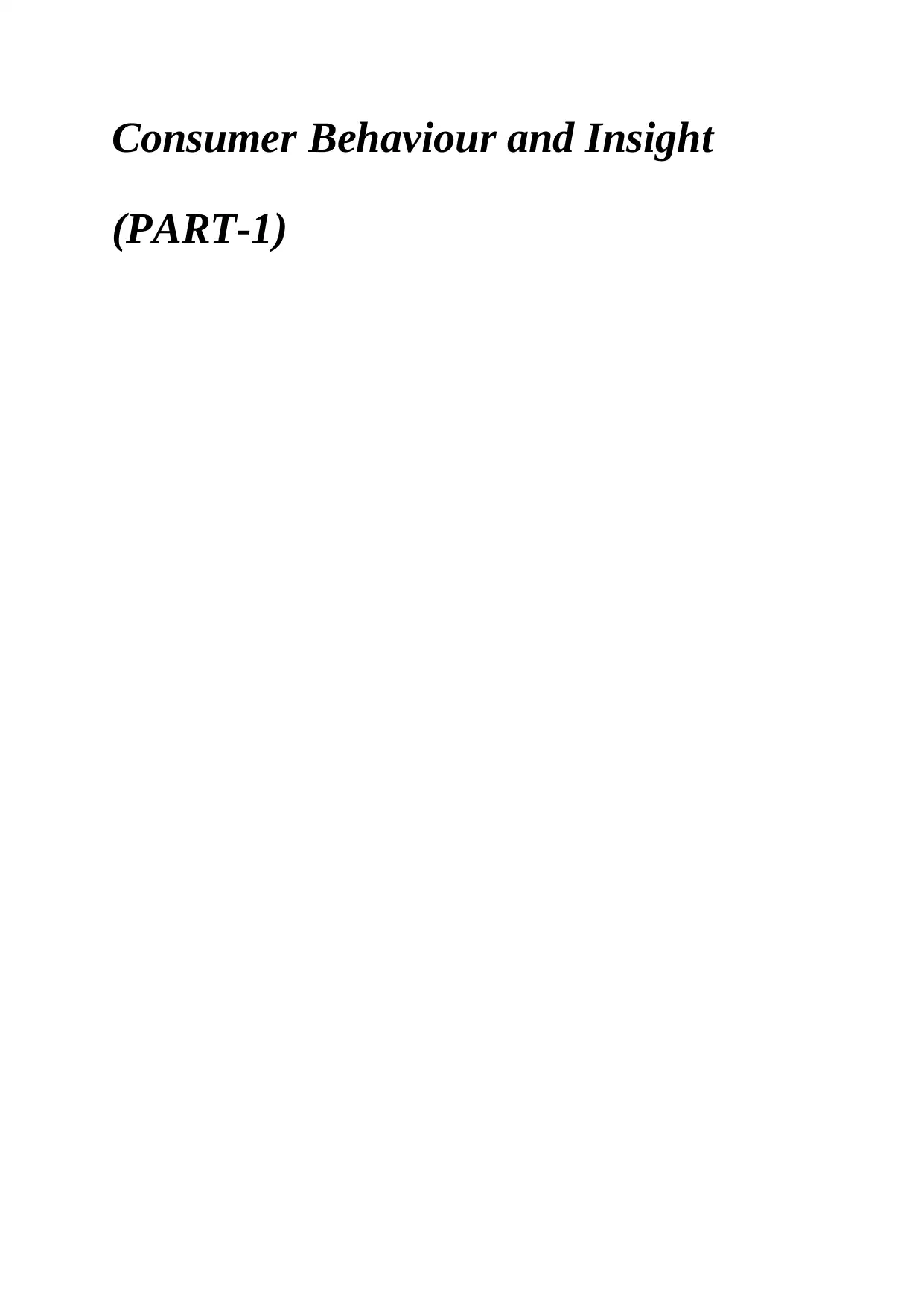
Consumer Behaviour and Insight
(PART-1)
(PART-1)
Paraphrase This Document
Need a fresh take? Get an instant paraphrase of this document with our AI Paraphraser
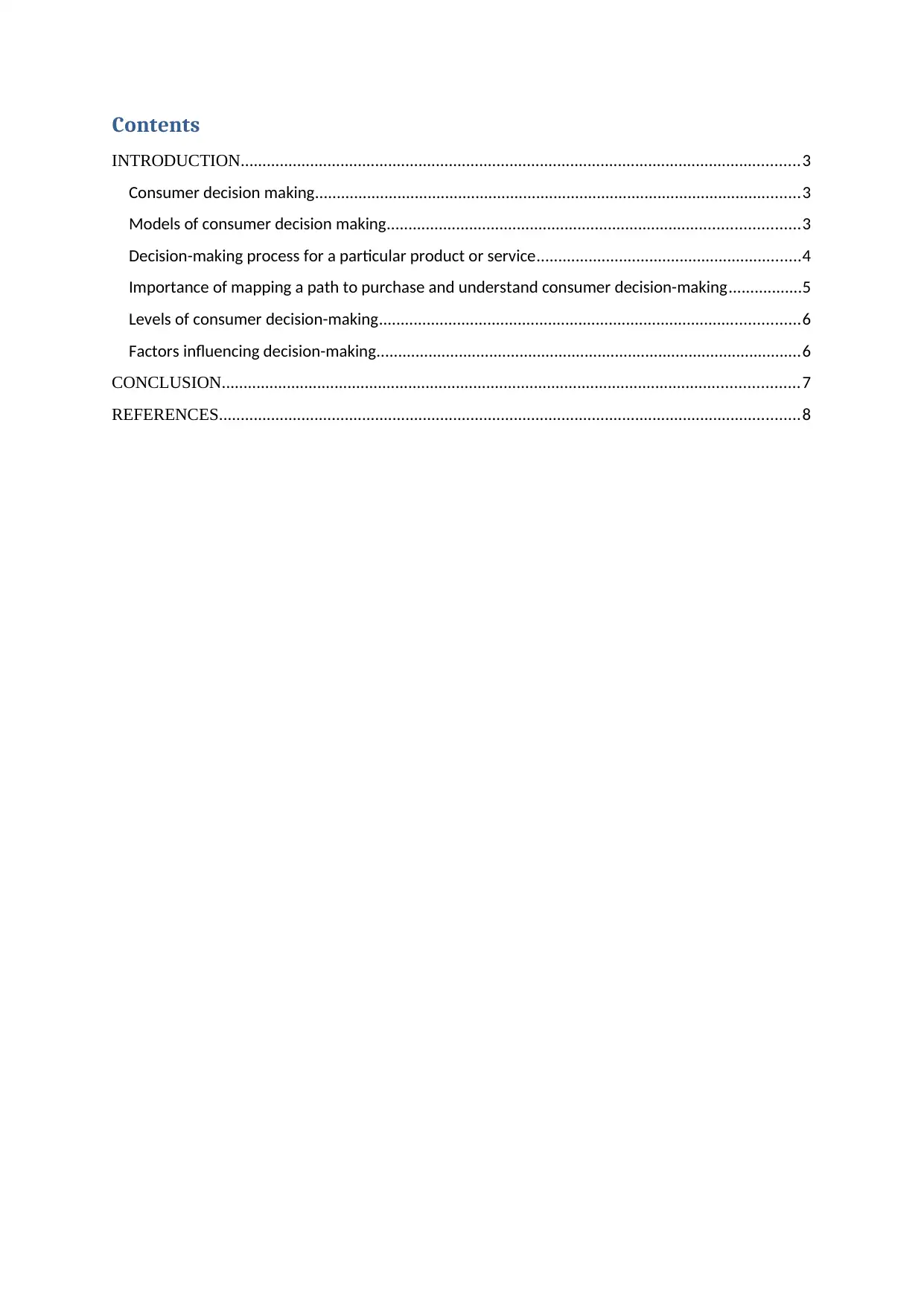
Contents
INTRODUCTION.................................................................................................................................3
Consumer decision making................................................................................................................3
Models of consumer decision making...............................................................................................3
Decision-making process for a particular product or service.............................................................4
Importance of mapping a path to purchase and understand consumer decision-making.................5
Levels of consumer decision-making.................................................................................................6
Factors influencing decision-making..................................................................................................6
CONCLUSION.....................................................................................................................................7
REFERENCES......................................................................................................................................8
INTRODUCTION.................................................................................................................................3
Consumer decision making................................................................................................................3
Models of consumer decision making...............................................................................................3
Decision-making process for a particular product or service.............................................................4
Importance of mapping a path to purchase and understand consumer decision-making.................5
Levels of consumer decision-making.................................................................................................6
Factors influencing decision-making..................................................................................................6
CONCLUSION.....................................................................................................................................7
REFERENCES......................................................................................................................................8

INTRODUCTION
Consumer behaviour may defined as an activity of studying the buying behaviour of
customers which makes huge impacts on the sustainability and profitability of business
organisation. Due to this, an organisation must required to identify actual needs and
requirements of customers through conducting different type of market research. The present
assignment report is based on FASTFOOD company which is a British Frozen food
supermarket. It was established in the year 1965 and from then to now, it has operated more
than 300 stores throughout the UK. The project discusses the concept of consumer decision
making along with its different models, Importance of mapping a path to purchase and
understand consumer decision-making, Levels of consumer decision-making along with
factors influencing them.
Consumer decision making
It is the process of selecting suitable products according the needs and requirements of
customers at the time of purchasing in the market. Consumer decision making process may
influenced due to several factors such as price of product, wide varieties exist in the market
etc. Thus, the consumers make decision while buying products according to their suitability
and needs (Fulgoni, 2014).
Models of consumer decision making
There are various models of consumer decision making some of which are mentioned
as under:
Economic model: This model states that the consumers are rational at the time of
purchasing as they have a habit of analysing the product first and purchase according to their
requirements without spending unnecessary money. Such model is determined as unrealistic
as the people have limited skills, values and conceptualisation and are not always rational at
the time of making purchasing decision.
Passive model: This model states that consumer took buying decision on the basis of
advertising made by Farmfoods Ltd. as it influences their interest and willingness to buy. For
this, Farmfoods Ltd. must have an appealing advertisements and offers which brings
customers into confidence that their acquired products will brings beneficial outcome to
them. Such model is also determined as unrealistic model as the consumers first collect
information about products through advertisements and make buying decisions accordingly.
Consumer behaviour may defined as an activity of studying the buying behaviour of
customers which makes huge impacts on the sustainability and profitability of business
organisation. Due to this, an organisation must required to identify actual needs and
requirements of customers through conducting different type of market research. The present
assignment report is based on FASTFOOD company which is a British Frozen food
supermarket. It was established in the year 1965 and from then to now, it has operated more
than 300 stores throughout the UK. The project discusses the concept of consumer decision
making along with its different models, Importance of mapping a path to purchase and
understand consumer decision-making, Levels of consumer decision-making along with
factors influencing them.
Consumer decision making
It is the process of selecting suitable products according the needs and requirements of
customers at the time of purchasing in the market. Consumer decision making process may
influenced due to several factors such as price of product, wide varieties exist in the market
etc. Thus, the consumers make decision while buying products according to their suitability
and needs (Fulgoni, 2014).
Models of consumer decision making
There are various models of consumer decision making some of which are mentioned
as under:
Economic model: This model states that the consumers are rational at the time of
purchasing as they have a habit of analysing the product first and purchase according to their
requirements without spending unnecessary money. Such model is determined as unrealistic
as the people have limited skills, values and conceptualisation and are not always rational at
the time of making purchasing decision.
Passive model: This model states that consumer took buying decision on the basis of
advertising made by Farmfoods Ltd. as it influences their interest and willingness to buy. For
this, Farmfoods Ltd. must have an appealing advertisements and offers which brings
customers into confidence that their acquired products will brings beneficial outcome to
them. Such model is also determined as unrealistic model as the consumers first collect
information about products through advertisements and make buying decisions accordingly.
⊘ This is a preview!⊘
Do you want full access?
Subscribe today to unlock all pages.

Trusted by 1+ million students worldwide

Cognitive model: This model states that the consumer took buying decisions according
to their needs and requirements without getting influences by other organisational activities.
Thus, it is determined as best model among others as actual needs and preferences gets main
priority at the time of purchasing.
Emotional model: This model is based on the assumptions that the consumer buy
products and services on the basis of emotional aspects of their behaviour. It means the
consumers buy products when they emotionally touched or related themselves with the
products and services. Such kind of impulsive behaviour consumer less time in buying
product which can either make negative or positive impact on them in future (Gargiulo,
Natale and Russo, 2015).
Decision-making process for a particular product or service
Decision making process refers to the process of picking best products or services from
the market by the customers with the help of using their market knowledge, information
gathered through promotional activities etc. The buying decision of consumers can be
addressed using economic and psychological factors. It is complex in nature due to starting
process of buying from identifying the needs and preferences to the post purchase evaluation.
Farmfoods Ltd. is UK-based organisation operating at small-medium scale. Thus, it is
important for them to identify the basis on which consumer buy their products and services.
Here are the steps followed by consumers before making decisions regarding buying
products and services:
Need/problem recognition: The decisions of buying starts with the recognition of
needs, preferences and purpose in the mind of consumer. The changing market trends drives
the behaviour of consumers that they are lacking of something and motivate them to purchase
in order to fulfil their actual needs and requirements. For example, consumer buys grocery
product for the daily household purpose (Gillingham and Palmer, 2014).
Information search: The buying decision of consumers are mainly depends on the
information gathered during research about particular products and services. It facilitate
consumers to collect sufficient information which is necessary before buying. For example,
cost, quality, benefits and other features of products. In the context of Farmfoods Ltd., the
consumers buys products through taking advices or opinions from the friends or relatives
who have previously used such product. Getting information through advertisements made
by Farmfoods Ltd. can also encourages consumer to make decisions whether to buy or not.
to their needs and requirements without getting influences by other organisational activities.
Thus, it is determined as best model among others as actual needs and preferences gets main
priority at the time of purchasing.
Emotional model: This model is based on the assumptions that the consumer buy
products and services on the basis of emotional aspects of their behaviour. It means the
consumers buy products when they emotionally touched or related themselves with the
products and services. Such kind of impulsive behaviour consumer less time in buying
product which can either make negative or positive impact on them in future (Gargiulo,
Natale and Russo, 2015).
Decision-making process for a particular product or service
Decision making process refers to the process of picking best products or services from
the market by the customers with the help of using their market knowledge, information
gathered through promotional activities etc. The buying decision of consumers can be
addressed using economic and psychological factors. It is complex in nature due to starting
process of buying from identifying the needs and preferences to the post purchase evaluation.
Farmfoods Ltd. is UK-based organisation operating at small-medium scale. Thus, it is
important for them to identify the basis on which consumer buy their products and services.
Here are the steps followed by consumers before making decisions regarding buying
products and services:
Need/problem recognition: The decisions of buying starts with the recognition of
needs, preferences and purpose in the mind of consumer. The changing market trends drives
the behaviour of consumers that they are lacking of something and motivate them to purchase
in order to fulfil their actual needs and requirements. For example, consumer buys grocery
product for the daily household purpose (Gillingham and Palmer, 2014).
Information search: The buying decision of consumers are mainly depends on the
information gathered during research about particular products and services. It facilitate
consumers to collect sufficient information which is necessary before buying. For example,
cost, quality, benefits and other features of products. In the context of Farmfoods Ltd., the
consumers buys products through taking advices or opinions from the friends or relatives
who have previously used such product. Getting information through advertisements made
by Farmfoods Ltd. can also encourages consumer to make decisions whether to buy or not.
Paraphrase This Document
Need a fresh take? Get an instant paraphrase of this document with our AI Paraphraser

Evaluation of alternatives: There are various alternatives in products aand services
offered by different organisations in the market which makes easy for consumer to
differentiate and buy products according to their needs and requirements. This evaluation of
product directs Farmfoods Ltd. to update their offerings on regular time period in order to get
top priority from the consumers at the of buying.
Selection and trial: This is the step in which the consumer make trial of products first
and make buy decisions accordingly. Sometimes the consumers get confused at the time
purchasing due to which they first try products in small quantities and if they get satisfaction
then the decision will be made in future to buy same product in huge quantity.
Purchase decision: Under this step, the consumer finally took decision regarding
whether to buy products and services or not after ensuring to get maximum level of
satisfaction. Such decisions involves choice of products, brand, dealer and quantity of the
purchase (Japee, 2015).
Post-purchase evaluation: This is the last and final stage of buying decision process.
In this stage, the consumers evaluate the effectiveness of product after consuming on the
basis of which Farmfoods Ltd. receives feedback on their products and services. If the
consumers get maximum satisfactions and feel to get optimum value in exchange of their
money then the sustainability of Farmfoods Ltd. may gone longer and vice-versa.
Importance of mapping a path to purchase and understand consumer decision-making
The path to purchase includes channels that the customers go through at the time of
buying process for a product or service. It refers to the journey map of customers which goes
through a research process executed before making decision of buying.
For an instance:
The consumer construct a map in which they decide to buy products and services on the basis
of their needs and requirements. For this, they first evaluate the alternate products and then
make final decisions that whose products should be taken on priority while decision making
process. Here are the some crucial steps involved in mapping a path to purchase:
It facilitate consumers in preparing a tailored experience in their buying decisions
making process (Nagengast and et. al., 2014).
offered by different organisations in the market which makes easy for consumer to
differentiate and buy products according to their needs and requirements. This evaluation of
product directs Farmfoods Ltd. to update their offerings on regular time period in order to get
top priority from the consumers at the of buying.
Selection and trial: This is the step in which the consumer make trial of products first
and make buy decisions accordingly. Sometimes the consumers get confused at the time
purchasing due to which they first try products in small quantities and if they get satisfaction
then the decision will be made in future to buy same product in huge quantity.
Purchase decision: Under this step, the consumer finally took decision regarding
whether to buy products and services or not after ensuring to get maximum level of
satisfaction. Such decisions involves choice of products, brand, dealer and quantity of the
purchase (Japee, 2015).
Post-purchase evaluation: This is the last and final stage of buying decision process.
In this stage, the consumers evaluate the effectiveness of product after consuming on the
basis of which Farmfoods Ltd. receives feedback on their products and services. If the
consumers get maximum satisfactions and feel to get optimum value in exchange of their
money then the sustainability of Farmfoods Ltd. may gone longer and vice-versa.
Importance of mapping a path to purchase and understand consumer decision-making
The path to purchase includes channels that the customers go through at the time of
buying process for a product or service. It refers to the journey map of customers which goes
through a research process executed before making decision of buying.
For an instance:
The consumer construct a map in which they decide to buy products and services on the basis
of their needs and requirements. For this, they first evaluate the alternate products and then
make final decisions that whose products should be taken on priority while decision making
process. Here are the some crucial steps involved in mapping a path to purchase:
It facilitate consumers in preparing a tailored experience in their buying decisions
making process (Nagengast and et. al., 2014).
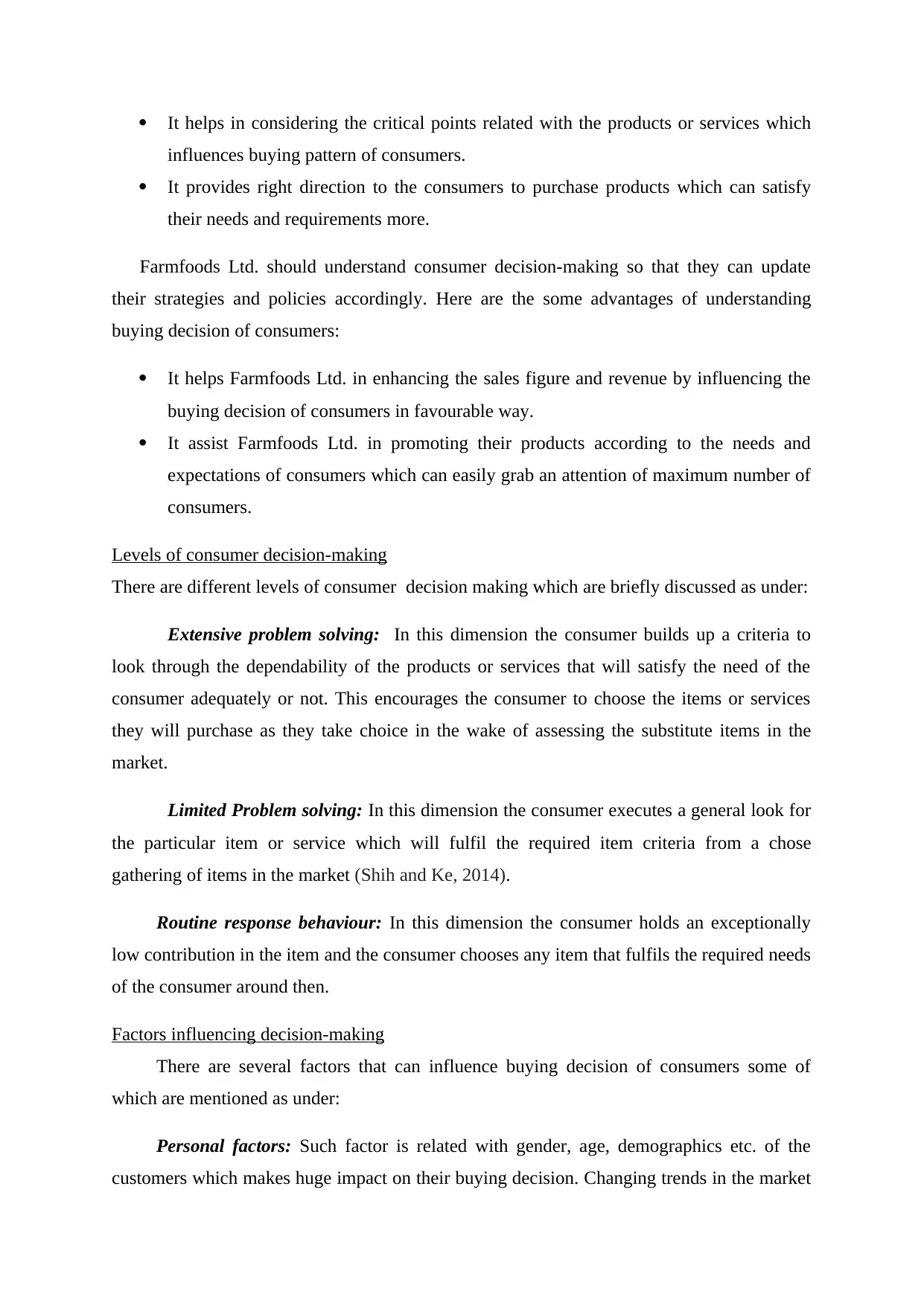
It helps in considering the critical points related with the products or services which
influences buying pattern of consumers.
It provides right direction to the consumers to purchase products which can satisfy
their needs and requirements more.
Farmfoods Ltd. should understand consumer decision-making so that they can update
their strategies and policies accordingly. Here are the some advantages of understanding
buying decision of consumers:
It helps Farmfoods Ltd. in enhancing the sales figure and revenue by influencing the
buying decision of consumers in favourable way.
It assist Farmfoods Ltd. in promoting their products according to the needs and
expectations of consumers which can easily grab an attention of maximum number of
consumers.
Levels of consumer decision-making
There are different levels of consumer decision making which are briefly discussed as under:
Extensive problem solving: In this dimension the consumer builds up a criteria to
look through the dependability of the products or services that will satisfy the need of the
consumer adequately or not. This encourages the consumer to choose the items or services
they will purchase as they take choice in the wake of assessing the substitute items in the
market.
Limited Problem solving: In this dimension the consumer executes a general look for
the particular item or service which will fulfil the required item criteria from a chose
gathering of items in the market (Shih and Ke, 2014).
Routine response behaviour: In this dimension the consumer holds an exceptionally
low contribution in the item and the consumer chooses any item that fulfils the required needs
of the consumer around then.
Factors influencing decision-making
There are several factors that can influence buying decision of consumers some of
which are mentioned as under:
Personal factors: Such factor is related with gender, age, demographics etc. of the
customers which makes huge impact on their buying decision. Changing trends in the market
influences buying pattern of consumers.
It provides right direction to the consumers to purchase products which can satisfy
their needs and requirements more.
Farmfoods Ltd. should understand consumer decision-making so that they can update
their strategies and policies accordingly. Here are the some advantages of understanding
buying decision of consumers:
It helps Farmfoods Ltd. in enhancing the sales figure and revenue by influencing the
buying decision of consumers in favourable way.
It assist Farmfoods Ltd. in promoting their products according to the needs and
expectations of consumers which can easily grab an attention of maximum number of
consumers.
Levels of consumer decision-making
There are different levels of consumer decision making which are briefly discussed as under:
Extensive problem solving: In this dimension the consumer builds up a criteria to
look through the dependability of the products or services that will satisfy the need of the
consumer adequately or not. This encourages the consumer to choose the items or services
they will purchase as they take choice in the wake of assessing the substitute items in the
market.
Limited Problem solving: In this dimension the consumer executes a general look for
the particular item or service which will fulfil the required item criteria from a chose
gathering of items in the market (Shih and Ke, 2014).
Routine response behaviour: In this dimension the consumer holds an exceptionally
low contribution in the item and the consumer chooses any item that fulfils the required needs
of the consumer around then.
Factors influencing decision-making
There are several factors that can influence buying decision of consumers some of
which are mentioned as under:
Personal factors: Such factor is related with gender, age, demographics etc. of the
customers which makes huge impact on their buying decision. Changing trends in the market
⊘ This is a preview!⊘
Do you want full access?
Subscribe today to unlock all pages.

Trusted by 1+ million students worldwide
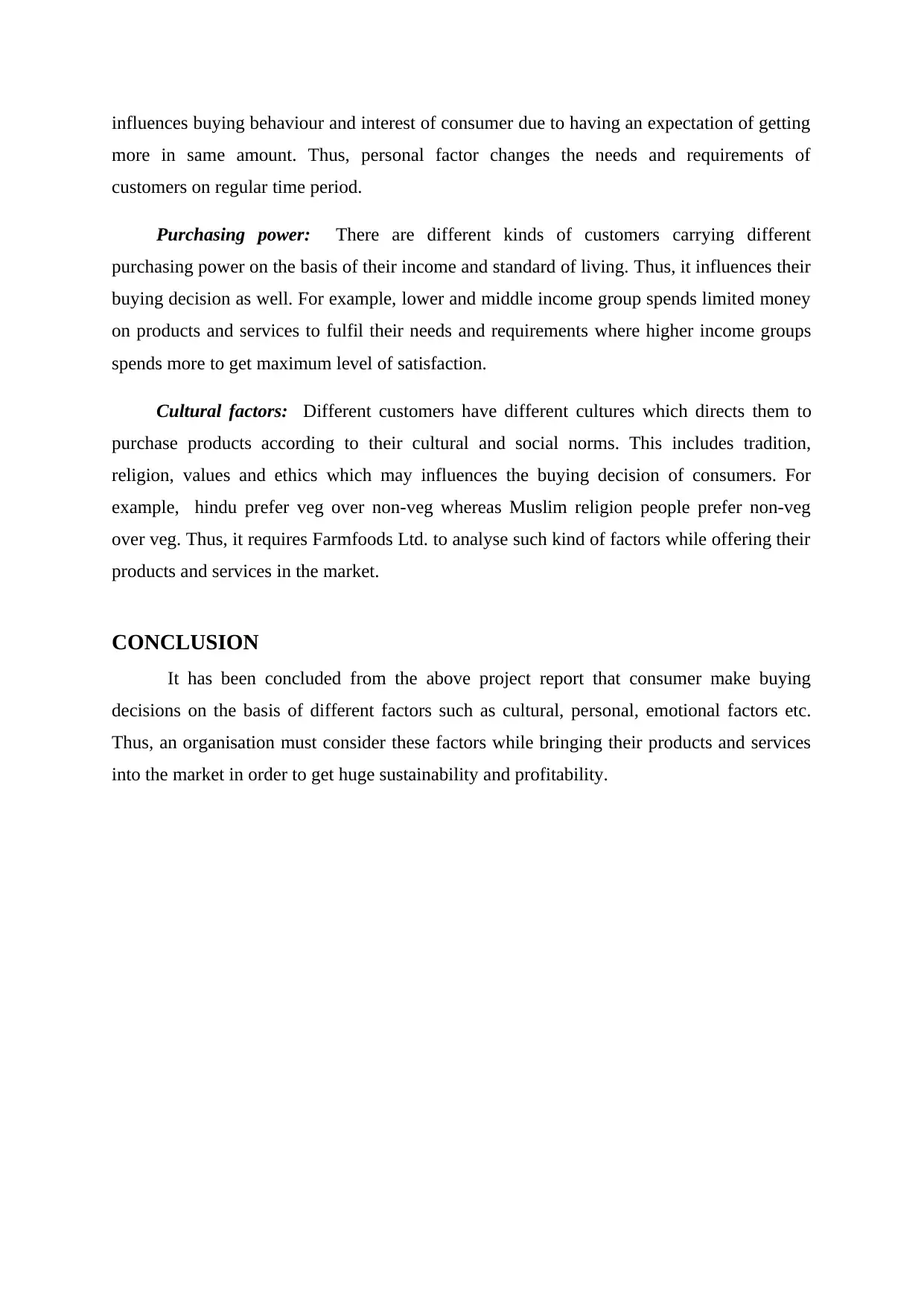
influences buying behaviour and interest of consumer due to having an expectation of getting
more in same amount. Thus, personal factor changes the needs and requirements of
customers on regular time period.
Purchasing power: There are different kinds of customers carrying different
purchasing power on the basis of their income and standard of living. Thus, it influences their
buying decision as well. For example, lower and middle income group spends limited money
on products and services to fulfil their needs and requirements where higher income groups
spends more to get maximum level of satisfaction.
Cultural factors: Different customers have different cultures which directs them to
purchase products according to their cultural and social norms. This includes tradition,
religion, values and ethics which may influences the buying decision of consumers. For
example, hindu prefer veg over non-veg whereas Muslim religion people prefer non-veg
over veg. Thus, it requires Farmfoods Ltd. to analyse such kind of factors while offering their
products and services in the market.
CONCLUSION
It has been concluded from the above project report that consumer make buying
decisions on the basis of different factors such as cultural, personal, emotional factors etc.
Thus, an organisation must consider these factors while bringing their products and services
into the market in order to get huge sustainability and profitability.
more in same amount. Thus, personal factor changes the needs and requirements of
customers on regular time period.
Purchasing power: There are different kinds of customers carrying different
purchasing power on the basis of their income and standard of living. Thus, it influences their
buying decision as well. For example, lower and middle income group spends limited money
on products and services to fulfil their needs and requirements where higher income groups
spends more to get maximum level of satisfaction.
Cultural factors: Different customers have different cultures which directs them to
purchase products according to their cultural and social norms. This includes tradition,
religion, values and ethics which may influences the buying decision of consumers. For
example, hindu prefer veg over non-veg whereas Muslim religion people prefer non-veg
over veg. Thus, it requires Farmfoods Ltd. to analyse such kind of factors while offering their
products and services in the market.
CONCLUSION
It has been concluded from the above project report that consumer make buying
decisions on the basis of different factors such as cultural, personal, emotional factors etc.
Thus, an organisation must consider these factors while bringing their products and services
into the market in order to get huge sustainability and profitability.
Paraphrase This Document
Need a fresh take? Get an instant paraphrase of this document with our AI Paraphraser
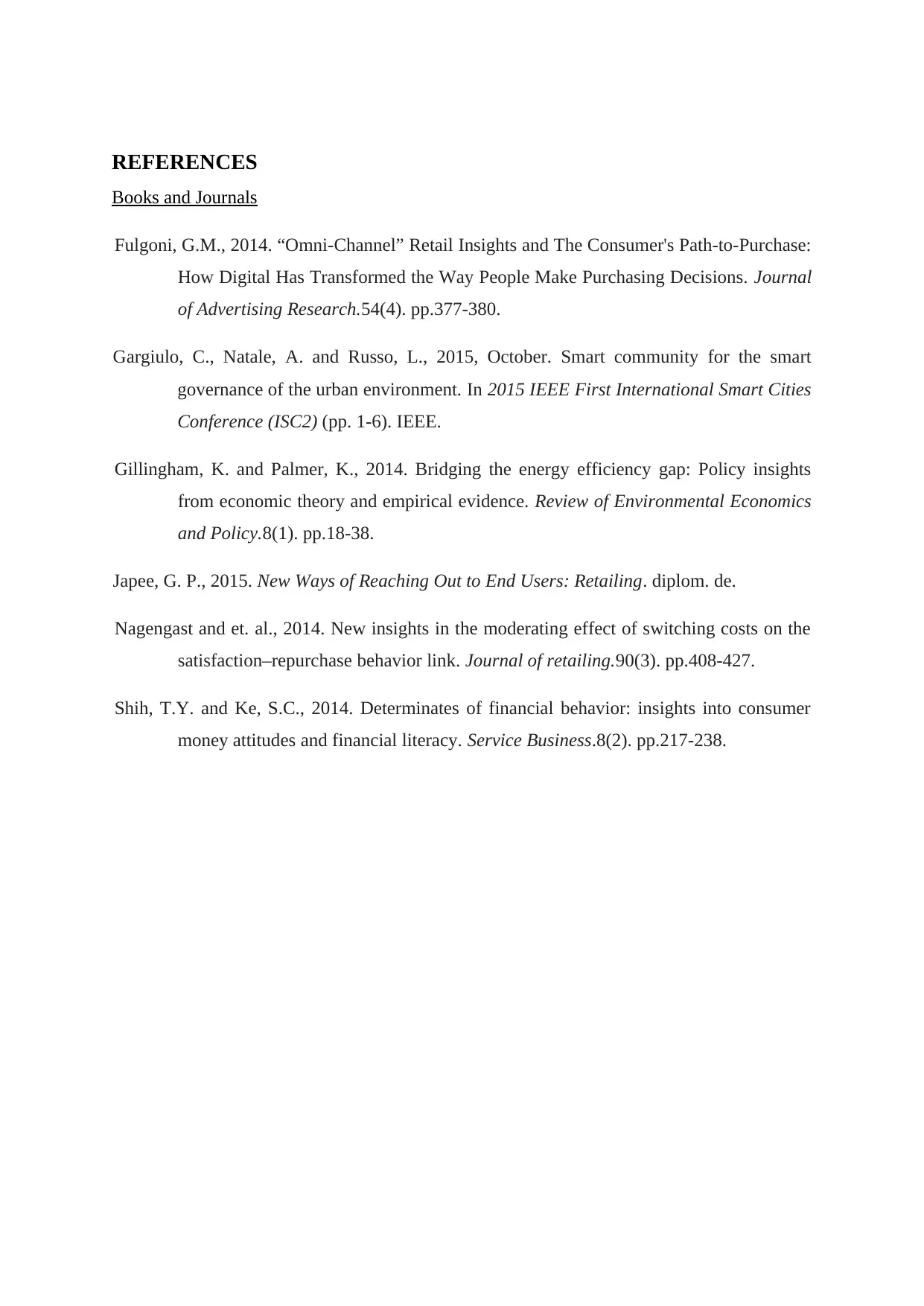
REFERENCES
Books and Journals
Fulgoni, G.M., 2014. “Omni-Channel” Retail Insights and The Consumer's Path-to-Purchase:
How Digital Has Transformed the Way People Make Purchasing Decisions. Journal
of Advertising Research.54(4). pp.377-380.
Gargiulo, C., Natale, A. and Russo, L., 2015, October. Smart community for the smart
governance of the urban environment. In 2015 IEEE First International Smart Cities
Conference (ISC2) (pp. 1-6). IEEE.
Gillingham, K. and Palmer, K., 2014. Bridging the energy efficiency gap: Policy insights
from economic theory and empirical evidence. Review of Environmental Economics
and Policy.8(1). pp.18-38.
Japee, G. P., 2015. New Ways of Reaching Out to End Users: Retailing. diplom. de.
Nagengast and et. al., 2014. New insights in the moderating effect of switching costs on the
satisfaction–repurchase behavior link. Journal of retailing.90(3). pp.408-427.
Shih, T.Y. and Ke, S.C., 2014. Determinates of financial behavior: insights into consumer
money attitudes and financial literacy. Service Business.8(2). pp.217-238.
Books and Journals
Fulgoni, G.M., 2014. “Omni-Channel” Retail Insights and The Consumer's Path-to-Purchase:
How Digital Has Transformed the Way People Make Purchasing Decisions. Journal
of Advertising Research.54(4). pp.377-380.
Gargiulo, C., Natale, A. and Russo, L., 2015, October. Smart community for the smart
governance of the urban environment. In 2015 IEEE First International Smart Cities
Conference (ISC2) (pp. 1-6). IEEE.
Gillingham, K. and Palmer, K., 2014. Bridging the energy efficiency gap: Policy insights
from economic theory and empirical evidence. Review of Environmental Economics
and Policy.8(1). pp.18-38.
Japee, G. P., 2015. New Ways of Reaching Out to End Users: Retailing. diplom. de.
Nagengast and et. al., 2014. New insights in the moderating effect of switching costs on the
satisfaction–repurchase behavior link. Journal of retailing.90(3). pp.408-427.
Shih, T.Y. and Ke, S.C., 2014. Determinates of financial behavior: insights into consumer
money attitudes and financial literacy. Service Business.8(2). pp.217-238.
1 out of 8
Related Documents
Your All-in-One AI-Powered Toolkit for Academic Success.
+13062052269
info@desklib.com
Available 24*7 on WhatsApp / Email
![[object Object]](/_next/static/media/star-bottom.7253800d.svg)
Unlock your academic potential
Copyright © 2020–2025 A2Z Services. All Rights Reserved. Developed and managed by ZUCOL.





